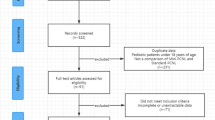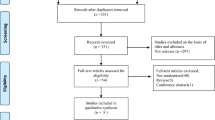Abstract
The aim of the study was to objectively analyze the outcomes for minimally invasive percutaneous nephrolithotomy (MPCNL) vs standard percutaneous nephrolithotomy (PCNL) by systematic review and meta-analysis of published data. A systematic literature review was performed in November 2014 using the PUBMED, EMBASE and Cochrane Library databases to identify relevant studies. Only comparative studies investigating MPCNL vs PCNL were included. Effect sizes were estimated by pooled odds ratio (ORs) and mean differences (MDs). The analyzed outcomes were stone-free rate (SFR), blood loss, pain assessment, operative time, hospital stay and complications. We identified 8 trials with a total 749 patients. 353 patients were treated with MPCNL and 396 with PCNL. Meta-analysis of the data showed that there was no difference in SFR between MPCNL and PCNL (OR 1.06, 95 % CI 0.71–1.58). Patients in the MPCNL group experienced less drop in hemoglobin (MD: −4.67 g/L, 95 % CI −7.29 to −2.04), a lower incidence of blood transfusion (OR 0.18, 95 % CI 0.06–0.54), less pain (visual analog score) (MD: −0.53, 95 % CI −0.94 to −0.13) and shorter hospitalization (MD: −1.32 days, 95 % CI −2.15 to −0.50). Operative time was longer in the MPCNL group (MD: 15.54 min, 95 % CI 4.25–26.83). Postoperative fever and pyelocalyceal perforation did not differ between the groups (p = 0.38 and 0.44, respectively). Current evidence suggested that MPCNL was a safe and effective procedure with an SFR comparable to that of PCNL. MPCNL resulted in less bleeding, fewer transfusion, less pain and shorter hospitalization. Well-designed multicentric/international randomized, controlled trials are still needed.



Similar content being viewed by others
References
Jackman SV, Hedican SP, Peters CA, Docimo SG (1998) Percutaneous nephrolithotomy in infants and preschool age children: experience with a new technique. Urology 52(4):697–701
Lahme S, Bichler KH, Strohmaier WL, Gotz T (2001) Minimally invasive PCNL in patients with renal pelvic and calyceal stones. Eur Urol 40(6):619–624
Feng MI, Tamaddon K, Mikhail A, Kaptein JS, Bellman GC (2001) Prospective randomized study of various techniques of percutaneous nephrolithotomy. Urology 58(3):345–350
Giusti G, Piccinelli A, Taverna G, Benetti A, Pasini L, Corinti M, Teppa A, Zandegiacomo De Zorzi S, Graziotti P (2007) Miniperc? No, thank you! Eur Urol 51(3):810–815. doi:10.1016/j.eururo.2006.07.047
Knoll T, Wezel F, Michel MS, Honeck P, Wendt-Nordahl G (2010) Do patients benefit from miniaturized tubeless percutaneous nephrolithotomy? A comparative prospective study. J Endourol 24(7):1075–1079. doi:10.1089/end.2010.0111
Li L, Gao X, Yang M, Li J, Zhang H, Xu W, Lin Z (2010) Does a smaller tract in percutaneous nephrolithotomy contribute to less invasiveness? A prospective comparative study. Urology 75(1):56–61. doi:10.1016/j.urology.2009.06.006
Cheng F, Yu W, Zhang X, Yang S, Xia Y, Ruan Y (2010) Minimally invasive tract in percutaneous nephrolithotomy for renal stones. J Endourol Soc 24(10):1579–1582. doi:10.1089/end.2009.0581
Zhong W, Zeng G, Wu W, Chen W, Wu K (2011) Minimally invasive percutaneous nephrolithotomy with multiple mini tracts in a single session in treating staghorn calculi. Urol Res 39(2):117–122. doi:10.1007/s00240-010-0308-z
Mishra S, Sharma R, Garg C, Kurien A, Sabnis R, Desai M (2011) Prospective comparative study of miniperc and standard PNL for treatment of 1 to 2 cm size renal stone. Bju Int 108(6):896–900. doi:10.1111/j.1464-410X.2010.09936.x
Song L, Chen Z, Liu T, Zhong J, Qin W, Guo S, Peng Z, Hu M, Du C, Zhu L, Yao L, Yang Z, Huang J, Xie D (2011) The application of a patented system to minimally invasive percutaneous nephrolithotomy. J Endourol 25(8):1281–1286. doi:10.1089/end.2011.0032
Xu S, Shi H, Zhu J, Wang Y, Cao Y, Li K, Wang Y, Sun Z, Xia S (2014) A prospective comparative study of haemodynamic, electrolyte, and metabolic changes during percutaneous nephrolithotomy and minimally invasive percutaneous nephrolithotomy. World J Urol 32(5):1275–1280. doi:10.1007/s00345-013-1204-2
Moher D, Shamseer L, Clarke M, Ghersi D, Liberati A, Petticrew M, Shekelle P, Stewart LA (2015) Preferred reporting items for systematic review and meta-analysis protocols (PRISMA-P) 2015 statement. Syst Rev 4(1):1. doi:10.1186/2046-4053-4-1
Clark HD, Wells GA, Huet C, McAlister FA, Salmi LR, Fergusson D, Laupacis A (1999) Assessing the quality of randomized trials: reliability of the Jadad scale. Control Clin Trials 20(5):448–452
G Wells, B Shea, D O’Connell, J Peterson, V Welch, M Losos, P Tugwell (2000) The Newcastle–Ottawa Scale (NOS) for assessing the quality of nonrandomised studies in meta-analyses. http://www.ohri.ca/programs/clinical_epidemiology/oxford.asp. Accessed 23 Nov 2014
Phillips B, Ball C, Sackett D et al (2009) Oxford centre for evidence-based medicine—levels of evidence. Centre for Evidence-Based Medicine Web site. http://www.cebm.net/oxford-centre-evidence-based-medicine-levels-evidence-march-2009/. Accessed 23 Nov 2014
Fernstrom I, Johansson B (1976) Percutaneous pyelolithotomy. A new extraction technique. Scand J Urol Nephrol 10(3):257–259
Zeng G, Zhu W, Li J, Zhao Z, Zeng T, Liu C, Liu Y, Yuan J, Wan SP (2014) The comparison of minimally invasive percutaneous nephrolithotomy and retrograde intrarenal surgery for stones larger than 2 cm in patients with a solitary kidney: a matched-pair analysis. World J Urol. doi:10.1007/s00345-014-1420-4
Kukreja R, Desai M, Patel S, Bapat S, Desai M (2004) Factors affecting blood loss during percutaneous nephrolithotomy: prospective study. J Endourol 18(8):715–722. doi:10.1089/end.2004.18.715
Sabnis RB, Ganesamoni R, Sarpal R (2012) Miniperc: what is its current status? Curr Opin Urol 22(2):129–133. doi:10.1097/MOU.0b013e3283502fb4
Acknowledgments
This work was financed by a Grant from National Natural Science Foundation, China (No. 81370804), Colleges and universities in Guangzhou Yangcheng scholars research project (No. 12A017S), and Science and technology project in Guangzhou (the people’s livelihood special major science and Technology) (No. 201300000096). The authors thank Professor Shaw P. Wan and Jody for improving the use of English in the manuscript.
Author information
Authors and Affiliations
Corresponding author
Ethics declarations
Conflict of interest
None declared.
Rights and permissions
About this article
Cite this article
Zhu, W., Liu, Y., Liu, L. et al. Minimally invasive versus standard percutaneous nephrolithotomy: a meta-analysis. Urolithiasis 43, 563–570 (2015). https://doi.org/10.1007/s00240-015-0808-y
Received:
Accepted:
Published:
Issue Date:
DOI: https://doi.org/10.1007/s00240-015-0808-y




